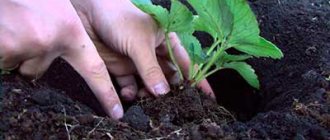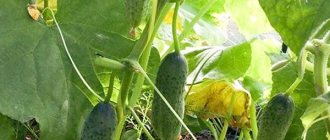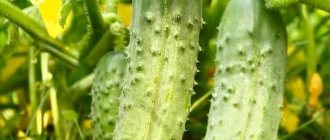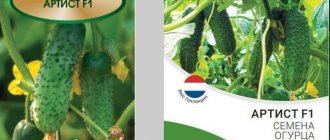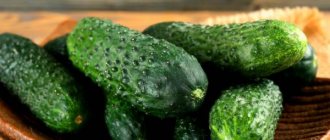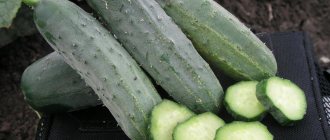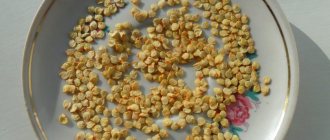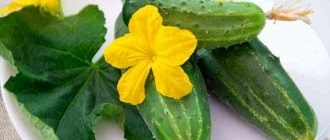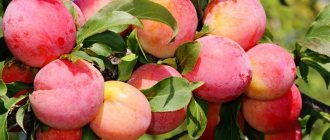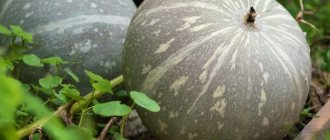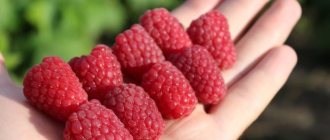Plant criteria
Description of Dolomite F1 cucumbers helps the summer resident to correctly place the plant on the site and avoid common mistakes when growing.
Plant:
- Parthenocarpic.
- Indeterminate.
- Medium height.
- Medium branched.
- The ovaries are bunched. There are 6-8 cucumbers in 1 bosom.
- Predominantly female type of flower.
- Ripens within 38-40 days.
Cucumber:
- Color: green with white stripes.
- Spikes: white.
- Length 10-14 cm.
- Diameter: 3.5-4 cm
- Weight: 100 g.
- Taste: excellent, not bitter.
- Density: medium.
- The skin is thin.
The Dutch variety of cucumbers is currently gaining popularity, thanks to positive reviews from summer residents.
Origin and description of the hybrid
Cucumber Dolomite F1 is the brainchild of the Dutch company Nunhems BV. The Russian State Register recognized the variety in 2010 as a crop for various planting sites (greenhouse, unprotected soil, greenhouses).
The culture is evolving quickly. The foliage does not interfere with fruiting and harvesting, since it sparsely covers the stem. Plant height – up to 1.5 m. Side branches of limited growth. The formed bunch inflorescence contains 6 – 8 fruits.
The maximum length of a cucumber is 12 cm. However, it can be picked when it reaches ¼ of its greatest length. The fruit is rich green at the stem and light green at the base, abundantly covered with tubercles and whitish fluff (see photo). A cucumber without voids or bitter aftertaste.
| By type of growth | Medium-climbing |
| Branching type | Medium branched |
| Type of pollination | Without bees (parthenocarpic) |
| Planting scheme | 50x50 cm |
| Weight, length and shape of the fruit | 70 - 100 g, 9-12 cm, short cylinder, pronounced green |
| Ripening period | Early ripening (38 – 42 days) |
| Method of use | Universal |
| Drop off point | Exhaust gas/greenhouse/greenhouses |
| Diseases | Protected against cucumber mosaic virus and olive spot. Immune reaction to powdery mildew (false, true) |
| Flowering type | Female |
| Productivity | 5-6 kg/m2 |
The variety is parthenocarpic, that is, insects are not needed for pollination; it pollinates itself. The flowering type is mainly female. It begins to bear fruit 38-42 days after emergence.
- Bushes of medium branching, many side shoots.
- Height - from 1 to 1.5 meters.
- Leaves are dark green
- The ovaries are formed in a bunch, in one bosom there are from 6 to 8 cucumbers.
Fruit:
- Cucumbers in the shape of a regular cylinder.
- The surface is decorated with numerous small tubercles.
- The length of the fruit is from 9 to 12 centimeters.
- Weight depending on length - from 80 to 100 grams.
- Diameter - approximately 3.5-3.8 centimeters.
In order to remove pickles from a bush, you need to start harvesting when the cucumbers stretch to 3-5 centimeters. If you want to remove the gherkins, then you should wait a little until the fruits become 5-8 centimeters long.
The skin of the cucumber is thin and dark green in color. The surface is covered with white spines and dense fringing. There are white stripes from the tips of the fruit to the middle. The flesh is crisp, without bitterness, even pickled cucumbers do not lose their crispness.
The yield is average - about 5-6 kilograms per square meter.
cucumber Gunnar F1 - description and characteristics of the variety
Now let's move on to a detailed description of the characteristics of some varieties of cucumbers mentioned earlier.
Hybrid "Balagan F1" is distinguished by its relative cold resistance, which makes it possible to grow this hybrid in spring unheated greenhouses (included in the State Register of the Russian Federation in 2010). It belongs to the early ripening, parthenocarpic, and is universal in purpose (salad, canning). The plant is indeterminate, but medium-sized and weakly branched.
Therefore, some position it as a “balcony” variety. The type of flowering is predominantly female; the formation of ovaries in the leaf axil occurs in bunches of 2-6 pieces. Zelentsy are short, spindle-shaped, ribbed with medium-sized tubercles and white pubescence of medium density, weighing 80-90 g with a marketable yield of about 11-13 kg/m2. The variety is resistant to viral mosaic (VOM1), fungal diseases (olive spot, powdery mildew) and tolerance to PMR.
Packaging of hybrid seeds “Balagan F1” and photographs of cucumbers of this variety
Hybrid “Bogatyr Power F1” The variety is included in the State Variety Commission of the Russian Federation. Designed for cultivation in protected soil conditions, does not require pollination (parthenocarpic). The type of flowering is female; nodes contain 3 or more flowers with ovaries. Fruiting is earlier, beginning on the 40th day after germination. Zelentsy are short, oval, weighing 100-115 g, slightly ribbed, medium-tubercular with white pubescence of medium density.
Packages of seeds of the hybrid “Bogatyrskaya Sila F1” from different manufacturers and a photo of cucumbers of this variety
Hybrid "Acorn F1" Suitable for growing in all regions in open ground and under film covers. The variety is bee-pollinated, female-flowering with a bunched arrangement of ovaries in nodes (from 3-5 to 10-12). In terms of ripening, it is classified as mid-early. The plant is indeterminate, medium-sized with weak climbing.
Zelentsy are short, fusiform, tuberculate with white pubescence of medium density. The average weight of greens (100-110 g) and good taste make the variety universal for fresh consumption and use in pickling and canning. It is characterized by high productivity (6-9 kg/m2) and resistance to diseases (cladosporiosis, VOM, MR), tolerance to LMR. The variety is included in the State Register of the Russian Federation.
Packages of hybrid cucumber seeds “Acorn F1” from different manufacturers
Hybrid "Karapuz F1" A hybrid variety intended for cultivation on private farms in protected soil conditions. Parthenocarpic, universal purpose, early ripening (fruiting begins on the 39-41st day after germination). The plant is indeterminate, medium-branched, the flowering type is female, the ovaries at the nodes are formed in bunches of 3 or more.
The green leaf is short, oval, slightly ribbed, with small tubercles and slight white pubescence. The taste of gherkin fruits is excellent, the average weight is 60-85 g, the yield is high - 10-12 kg/m2. It is resistant to common diseases of cucumbers: mosaic (BOM1), olive spot (cladosporiosis), powdery mildew (MP) and downy mildew (DMP). The variety is registered in the State Register of the Russian Federation.
Packages of hybrid cucumber seeds “Karapuz F1” from different manufacturers
Hybrid “Rodnichok F1” Traditionally popular hybrid variety, bred back in Soviet times. Due to its high yield (on average 18-24 kg/m2 in protected soil conditions and 5-7 kg/m2 in open soil) and resistance to diseases (anthracnose, ascochyta blight, powdery and downy mildew, olive spot), it is considered one of the best varieties for commercial production.
Growing is possible both in greenhouses or under film covers, and in open ground in many regions. The plant is indeterminate (up to 3 m), medium-branched, the flowering type is predominantly female. The ovaries in the nodes are laid in small bunches (2-3 each). The hybrid is mid-season - the first harvest ripens by the 50th day.
Read more about this variety in this article.
Packages of hybrid cucumber seeds “Rodnichok F1” from different manufacturers
Hybrid "Farmer F1" Designed for cultivation in gardens and household plots, as well as for small farms. The hybrid is relatively cold-resistant, grows well in open ground or under film covers, where its yield can be 12-14 kg/m2. Refers to mid-season, bee-pollinated with a predominantly female type of flowering.
The ovaries are formed in the leaf axils singly or in pairs. The plant is indeterminate with long vines and medium branching. The greenery is spindle-shaped, dark green in color, with large sparse tubercles and white pubescence. The uniformity of the fruits (length 8-11 cm, diameter 3.5-4 cm, weight 95-105 g) is successfully combined with their excellent taste in fresh, salted and canned form. The hybrid is resistant to cladosporiosis, BOM1, MR and tolerant to LMR. The variety is included in the State Variety Commission of Russia.
Packages of hybrid cucumber seeds “Farmer F1” from different manufacturers
Hybrid “Hit of the season F1” A hybrid included in the State Register for cultivation in protected soil conditions, parthenocarpic and early ripening (fruiting begins on the 40th day after full germination). The plant is indeterminate, medium-branched, female flowers (with ovaries) are borne at the nodes in a bunch type (3 or more).
Zelentsy are short, cylindrical, with weak ribbing, large tubercles and white pubescence of medium density, weighing about 90-105 g. They are used fresh and canned. The variety is characterized by good yield (12 kg/m2) and high resistance to diseases (BOM1, MR, cladosporiosis, root rot; tolerant to LMR).
Packages of hybrid cucumber seeds “Hit of the season F1” from different manufacturers
Hybrid "Khrustik F1" Suitable for growing in unheated film greenhouses. Provides an early abundant harvest (14-15 kg/m2) of cucumbers of excellent taste, which are universal in use (salad, canned). The plant is indeterminate, vigorous and medium branched; parthenocarpic, the type of flowering is predominantly female, 2-3 flowers are formed in the nodes.
Packages of cucumber seeds of the hybrid “Khrustik F1” of different varieties. The variety is early, bee-pollinated, high-yielding, and universal in use. The plant is determinate (compact), resistant to adverse weather conditions and various diseases (bacteriosis, olive spot, powdery mildew). Zelentsy are small (on average 10 cm - 100 g), elongated-ovoid, dark green, and have high keeping quality, that is, shelf life without changing color or taste.
Read more about the variety in this article.
Packages of different cucumber seeds of the “Kustovoy” variety. The variety is valued for its good taste, especially when pickling. Belongs to mid-season, bee-pollinated (with mixed type of flowering). The plant is indeterminate, but medium-sized and medium-climbing, which provides a yield of about 3 kg/m2. Zelentsy weighing 95-100 g, short, cylindrical, have large tubercles and small black pubescence. Included in the State Register of the Russian Federation.
Packages of cucumber seeds of the “Monastyrsky” variety from different manufacturers
Planting seedlings
Cucumbers are grown in two ways, the first is seedlings. Seeds are sown in the prepared soil mixture 21 days before planting in a permanent place. The period is calculated individually; the vegetable grower determines it based on the climate of the region.
The mixture for seedlings is prepared in advance or purchased in stores. Take:
- 1 part of turf land.
- 1 part sand.
- 2 parts humus.
- A little wood ash.
After sowing, the cucumbers are covered with glass or polyethylene. This will speed up the germination of the plant. In order for the plants to grow strong and tolerate transplantation well, it is recommended to feed them with growth stimulants.
Cucumbers cannot tolerate transplantation, reacting very painfully to damage to the root system, so they are sown in peat pots or easily broken containers.
When growing cucumber seedlings, it is necessary to take precautions when watering; you should not overwater the plants and you should not let the soil dry out.
Features of agricultural technology
Seeds are purchased in special markets. Experts recommend disinfecting them in manganese and then soaking them in stimulants. If a vegetable grower cultivates a hybrid plant in a garden without shelter, then seedlings must be used for cultivation. If you have a greenhouse structure, the seeds can be sown directly on the beds. Growing seedlings begins with sowing seeds in containers filled with well-fed light soils. It is necessary to deepen the seeds by 1.5-2 cm.
Recommendation!
For planting seed, it is better to use cups made of peat, as this will make it easier to transport the seedlings to their permanent place of growth.
As soon as the sprouts sprout, they are fertilized with bird droppings or slurry. Watering is carried out once every 6 days with non-cold water. When 4-5 leaves appear on the bushes, they are transplanted into the garden. Garden bed:
- loosen;
- disinfected with manganese.
Organic matter or preparations with nitrogen, wood ash are added to the soil. After replanting, the seedling material is shed generously. The bush planting scheme is 0.5 by 0.4 m. No more than 4 bushes must be planted per square of sown area, otherwise there will be shadow.
May be interesting Description and characteristics of the cucumber variety Zyatek f1: planting and care When and how to feed cucumbers in a greenhouseFeatures of growing cucumbers of the "Berendey f1" variety at home
Proper preparation of seeds for sowing helps to increase productivity and the yield of early product. Planting the prepared hybrid seed directly into the ground is carried out in the same way as when cultivating seedlings.
The Dolomite f1 variety maintains high productivity when growing vegetables for the purpose of harvesting useful pickles and gherkins. Each climate has its own time for sowing in open ground. Despite sufficient resistance to low temperatures, seeds can only be sown in garden beds when the soil temperature is +18 °C, which guarantees high germination.
The sowing time in the central zone of the Russian Federation begins in early May and ends in early June. But when planting seedlings in the garden, the first harvest can usually be harvested 14 days earlier. To get an early harvest of cucumbers, it is necessary to prepare the maximum possible loose, porous substrate with a full amount of useful elements.
Watering is carried out frequently:
- The soil should be well moistened, but water should not stagnate under the stems.
- Irrigation is recommended to be done using warm water, which has been heated by the sun during the day.
- The plant should be watered correctly in the evening.
Organic compounds or minerals, the use of root and foliar methods - here each vegetable grower must decide for himself what to choose, which method is more suitable. But it is better to combine techniques. So, for example:
- For warm weather, it is recommended to carry out root feeding when the rhizome of the plants is well developed.
- If the weather is bad, it is rational to use the foliar method when treating the foliage of seedlings.
Whichever method you choose:
- The first time cucumbers are fertilized 15 days after planting;
- the second time - at the beginning of flowering;
- the third - during the period of fruit production.
If you want to increase the lifespan of the vegetable, you can feed it a fourth time. The plant perfectly accepts organic matter and minerals, and is quite cool towards chemicals.
Note!
Despite the fact that fruiting is guaranteed even in poor conditions, it is necessary to fertilize. This will make it possible to make the seedlings more resistant to diseases.
Fertilization with minerals:
- The first feeding under the rhizome. Take 5 g of ammophos per m2 and treat the plantings evenly. It is necessary to seal the preparation during the period of loosening the soil.
- The second fertilizer can be either root or foliar. For root feeding, 30 g of ammonium nitrate and superphosphate and 20 g of potassium nitrate are diluted per 10 liters. In the second case, 10 liters of water require 2 tablespoons of superphosphate and top treatment.
- The third time they feed at the root. In 10 liters dilute either 50 g of urea or 2 tablespoons of potassium nitrate.
- The fourth time they fertilize superficially. A 10 liter bucket of water requires 15 g of urea.
Application of organics:
- For the first feeding, it is ideal to take manure - 1 liter of slurry per 8 liters of water, or comfrey tincture in a ratio of 1:5.
- The second time they feed with ash: take 200 g of ash per 10 liters of water, combine everything and send it under the rhizome.
- For fertilizing the third time, Gumi is suitable: for 10 liters of water, 2 tablespoons of the substance is enough.
- The fourth time is fed outside the root. For feeding, the drug is prepared in advance. It is necessary to pour water into the rotted hay in a 1:1 ratio, let it sit for 2 days, and only after that can the plantings be processed. This makes it possible not only to extend the growing season, but also protects plants from pathologies such as powdery mildew.
Experts recommend that in order not to burn the seedlings, they should be properly watered with a watering can without a sprayer, pouring the preparation between the bushes. The pros also recommend fertilizing when it’s cloudy outside. Knowing which fertilizing is ideal for cucumber crops, it will be possible to rejuvenate the hybrid, preventing the appearance of yellowness on the foliage. This will also help normalize photosynthesis.
On a note!
By using foliar feeding using humus and pine needles at the root, you can significantly increase the period of fruiting.
It is necessary to loosen the soil once every 7 days. Improving rhizome ventilation accelerates the development of seedlings. This will kill some parasites located on the root of the cucumber crop. Mulch makes it possible to get rid of some fungi and bacteria. Weeding is carried out once every 14 days. If the weeds are not removed, the plants may become sick, as weeds carry diseases. Pests live on weeds and spoil the seedlings.
Weeding destroys both the weeds themselves and the parasites. To protect a hybrid crop from pathologies to which it has no immunity, experienced vegetable growers recommend treating it with medicinal agents against bacterial and fungal infections.
Direct sowing into beds
Some summer residents, preferring to injure the cucumbers less, sow them directly into the ground. To do this, you need to prepare the site in advance, add humus, mineral fertilizers and dig in the fall. Then in the spring they make holes, add humus and wood ash to each, sow and cover with polyethylene. After the plants emerge, the film is removed.
See also
Types of cucumber pests, their control and treatmentRead
Advantages and disadvantages
Gardeners confirm the benefits of the variety declared by the breeders:
- The cucumber can be picked at the ripening stage to obtain pickles.
- The fruits are delicious in salads, preserves, and marinades.
- Vegetables ripen in a short time.
- The crop yield is above average.
- The plant has the ability to quickly recover after a pest invasion.
- Immunity from a number of diseases of similar vegetable crops.
- The cucumber is clearly visible on the stem due to its sparse foliage.
- The fruits tolerate long-term transportation well.
Disadvantages noted:
- lower disease resistance than other hybrids;
- seeds from your own harvest are not suitable for planting next season.
Caring for Dolomite cucumbers
Hybrid Dolomite is unpretentious and undemanding in terms of care, but following simple agrotechnical requirements will help to significantly increase the plant’s productivity.
- Weeding. Removing weeds will save you from attacks by insect pests.
- Loosening. Provides oxygen access to the roots.
- Watering. It is recommended to use warm water, water after sunset.
- Feeding. Several times a season, organic and complex mineral fertilizers are used.
Growing the hybrid vertically will help avoid infection with common diseases and provide oxygen access to the plant.
Care
Hybrid "Dolmite" is easy to care for, but you must follow some care recommendations:
- The recommended frequency of watering is once every two to three days. The soil should be moderately moist. Watering should be done with warm, settled water, heated in a barrel under the sun's rays. Watering is carried out in the evening;
- Feed the plants 3-4 times during the growing season. At the beginning, organic or nitrogen fertilizers are applied. As soon as the flowers appear, feed them with phosphorus-containing mixtures. During the formation of the first fruits, plants are fed with potassium and nitrogen fertilizers;
- Loosening is carried out once a week. Thanks to the procedure, ventilation of the root system is improved and the growth of bushes is accelerated;
- With the help of weeding, we get rid of weeds on which pests parasitize;
- As a result of mulching, moisture is retained in the soil for a long time, and weed growth is also slowed down.
You can prevent shoots with greens from lodging on the ground and prevent the occurrence of putrefactive diseases as a result of contact with the surface of the earth by tying up bushes.
Immunity, hybrid yield and its use in home cooking
Dolomite cucumbers are resistant to powdery mildew, cucumber mosaic virus and cladosporiosis. For other diseases, preventive treatments are required. Before flowering they use chemicals, after which they use traditional methods of control.
The yield of the variety is 4.9 kg per 1m2. The fruits of the hybrid are used for preparing fresh salads, canning and winter preparations. Suitable for preparing pickles and gherkins.
Reviews
The Dolomite F1 variety is among the favorites among summer residents. It is loved for its voluminous harvest and ease of care.
Dolomite is in demand among gardeners. The hybrid has exceptional advantages. It fully meets the requirements of gardeners. High yields please those who sell vegetables, which are also resistant to long-term transportation. The variety is suitable for both beginners and experienced gardeners.
- Tanya, 29 years old: We grew Dolomite in a greenhouse for sale. I was pleased with the good harvest - almost 350 kilograms of cucumbers were picked from 70 bushes. Very tasty, with a thin peel, we and our customers liked them. And in the fall I was pleasantly surprised - when the lashes dried up, stepchildren appeared. And they began to bloom, and cucumbers appeared again. Two harvests per season is very good.
- Veronica O., 31 years old: I don’t have much dacha experience, but I grow cucumbers in quantities - the whole family eats them in all types. Dolomite cucumbers are the same size, the harvest is large, the taste is great. There was enough for salads and winter preparations. And some of it was distributed to friends.
cucumber Director F1 - description and characteristics of the variety
Advantages of the variety
The gardener pays attention to the advantages of the variety; the more there are, the higher the likelihood of choice. The presence of a large number of disadvantages leads to the fact that the hybrid becomes unclaimed.
Pros:
- Productivity is high.
- The versatility of fruit use.
- Suitable for collecting pickles and gherkins.
- High commercial quality.
- Long shelf life.
- Resistant to low temperatures and some crop diseases.
- In case of lack of watering or excess watering, it is easily restored.
- The thin peel makes Dolomite cucumbers especially tasty when canned.
The hybrid has no disadvantages. This is why summer residents appreciate this species.
Characteristics and features of growing cucumber “Dolomite f1”
Dolomite F1 was created by Dutch breeders from the company Nunhems BV. Its features include unpretentiousness in care, growing conditions and versatility of use. The variety is suitable for planting in any region of the Russian Federation. It was entered into the state register in 2010, authorship belongs to Andreas Gertz
Characteristic
Hybrid Dolomite is an early ripening variety, from which the greens can be harvested 40 days after the shoots appear.
Fruits of the crop:
- cylindrical shape;
- with weak ribbing;
- covered with small green whitish stripes;
- have mild spotting;
- have a thin, finely tuberous skin and fairly dense pubescence;
- with white spikes;
- with dense pulp without bitterness;
- grow no more than 12 cm in length and up to 3.8 cm in diameter;
- weigh no more than 100 g.
The bushes of the hybrid are indeterminate, open, medium-sized, medium-climbing, with foliage of medium size and green color.
Positive qualities include:
- early ripening;
- taste properties;
- unpretentiousness;
- high level of productivity up to 5 kg per 1 m 2;
- Areas of use;
- presentation;
- long storage period;
- resistance to transportation;
- resistance to low temperatures and sudden changes;
- disease resistance;
- the ability to collect fruits when they have grown to the size of pickles.
The variety has no disadvantages.
Dolomite is not susceptible to attacks by cucumber mosaic virus, olive spot and powdery mildew. To exclude the formation of other diseases, it is advisable to carry out preventive measures. In particular, treat the seed material and the plants themselves, following the instructions for the selected preparations. The use of chemicals is prohibited at the time of flowering and at the beginning of fruiting.
Agricultural technology
In order for the harvest to be rich and tasty, you must first purchase high-quality seed material. Despite the fact that Dolomite is a hybrid, the seeds are disinfected with a manganese solution before planting, and then immersed in a special composition that stimulates growth.
In a greenhouse, it is permissible to plant seeds directly into the garden bed, but only when the soil is already well warmed up.
Seedlings are grown like this:
- Select containers, for example, containers or peat pots.
- They purchase or prepare their own soil, which must be disinfected, thoroughly fertilized and light.
- Planted in holes 15-20 mm deep.
Peat cups are an ideal option, as they can be planted in the garden bed along with the sprout, which will eliminate stress on the bushes. After the first shoots appear, the seedlings are fed with either chicken droppings or manure. Water every 5 days and only with warm water.
As soon as 5 true leaves grow, they can be transplanted into the bed that was previously:
- loosen;
- disinfected with potassium permanganate;
- fertilize with nitrogen, wood ash and organic matter.
After transplantation, the bushes are shed generously with warm water. The permissible and recommended arrangement of sprouts is 0.5 x 0.4 m. It is advisable to plant no more than 4 plants per 1m2. Denser placement will result in shading.
In the garden bed, the hybrid requires watering once every 3 days, but you need to inspect the soil. If it is well moistened or it has rained, then the break may be longer. It is forbidden to form puddles under stems and foliage. Water the plant so that water does not get on the leaves. To moisturize, you should choose the evening time.
Regular loosening is necessary. It should be done at least once a week, which will help improve ventilation of the root system. This will have a beneficial effect on growth and development, and helps eliminate garden pests that parasitize the roots of the cucumber.
Regular mulching is a way to prevent fungal and bacterial diseases. Weeding is enough once every 2 weeks. If weeds are not removed, they will not only destroy young shoots and weak roots, but will also act as a carrier of diseases. Weeds are home to a large number of pests that can seriously harm cucumbers. To protect plantings from diseases to which there is no immunity, it is recommended to spray the bushes with medicinal preparations.
According to numerous studies by breeders, it was revealed that 3-4 feedings are sufficient for the entire season:
- 14 days after the seed is planted. Fertilizer – potassium-nitrogen.
- At the beginning of flowering. Potassium-nitrogen and mineral fertilizer, supplemented with magnesium and boron.
- During the period of the beginning of fruiting. The composition and proportions should be the same as in the previous version, however, the nitrogen component must be selected in limited quantities.
- In the second half of the fruiting period, which will increase its duration and abundance. A component, phosphorus, is added to the previously described composition.
If the soil under the cucumber is too poor, then it is additionally fed with complex fertilizer. To stimulate the growth of cucumber vines and increase the number of fruits, you must carefully observe the timing of fertilizing.
Every gardener must remember that no crop will grow without fertilizing, but an excess of nutrients can negatively affect their growth and development. To determine whether a plant is overfertilized or, on the contrary, needs to be fertilized, you should pay attention to the following points:
- Nitrogen deficiency. Symptoms – cucumbers have too light peel color and irregular shape. The fruits look like cones, with a thickened stalk and they taper to a tail with a flower. To correct the situation, you can feed the bushes with urea, and after a week add ammonium nitrate. It is important to adhere to the proportions indicated on the packaging, otherwise the ovaries may crumble.
- In mid-summer, there is a significant lack of potassium. This can be determined by the presence of a yellow tint on the peel of the cucumbers and by their pear-shaped shape. They will be thin in the stalk area and thick near the flower. The leaves begin to lighten and curl. In this case, foliar feeding is necessary with potassium salt, which will require 2 tsp, and after a few days, the thoroughly spilled soil is sprinkled with potassium sulfate.
Description of popular varieties of cold-resistant cucumbers
Rating of the best varieties of cold-resistant cucumbers for open ground:
- Amur. This early-ripening hybrid is recommended for growing on private estates and small farms. The plant forms very weak branching, which makes it possible not to use shaping (pinching). Length 12-15 cm, weight - 90-110 g. The disadvantage of the variety is the short fruiting period (no more than 30 days). Cucumbers are picked every 2-3 days. Overripe fruits lose their good taste.
- Eskimo. Bee-pollinated variety. Even at low temperatures (5-7 degrees), the growing season does not stop. The fruits are cylindrical in shape with a thick peel, weighing up to 120 g. Cucumbers are suitable for salads, pickling, and canning.
- General's. The hybrid is early ripening, the bush grows tall and powerful. The variety is characterized by a large number of ovaries, in one bunch their number can reach up to 12. Zelentsy are very beautiful, reaching a length of 11 cm. From 1 m² you can harvest up to 40 kg of crop.
- Lapland. The first harvest ripens about a month after the first shoots appear. Wattles of medium length. Zelenets are 8-9 cm long, beautifully shaped. Ripe cucumbers are well suited for pickling in barrels. The advantage of the variety is the intensive formation of ovaries before autumn frosts.
- Lord. Lord (F1) cucumbers of the first generation belong to mid-season hybrids. An unpretentious crop is chosen for growing in outdoor beds and in film greenhouses. It has strong immunity to diseases. The first harvest can be harvested in August or early September. The bright green fruits with white spines are of high quality and excellent taste. Cucumbers are suitable for fresh consumption and canning.
- Snowstorm. This early type of vegetable does not require pollination. After 38-40 days you can harvest the first harvest. The small plant is characterized by poorly developed side shoots. There are up to 5 ovaries in one bunch. Cucumbers are small, only 6-8 cm in length and weighing 60-70 g. When they outgrow, they begin to grow in width. The disadvantage is the formation of voids in the fruit.
- Blizzard. An early-ripening hybrid with short wattles, producing the first harvest in 35-37 days. Dark green cucumbers are small (8 cm in length, weight - 70 g) with bright green stripes on the peel, which is covered with large pimples. Taste without bitterness.
- Eliseevsky. The plant is pollinated by bees. Mid-season variety, the first fruits ripen in 55-60 days. The highly lumpy fruits are juicy and tasty, ranging in size from 10 to 15 cm. Suitable for preservation.
- Dolomite. This early maturing hybrid was created by Dutch breeders. The bushes have few branches. The fruits are smooth, small-lumpy. The pulp is dense without bitterness. Does not lose its crunchy qualities after processing.
- Cucumber Bully (F1). Mid-season variety, first harvest in 40-45 days. Each bunched ovary produces 4-5 cucumbers. The fruit is 6-8 cm long with a dark green peel with whitish stripes. The fruiting period is long (until the first frost).
- Danila. Cucumber Danila is distinguished by intensive fruiting and the simultaneous formation of a large number of greens. The first harvest can be harvested in 35-40 days.
- Mill (F1). A high-yielding hybrid suitable for growing in greenhouses and open ground. The plant has average branching, the fruits with spines are 15-18 cm long.
Cucumber By Pike (F1), Tundra, Ant, Suomi, Sultan, Cheetah are hybrids that are also resistant to low temperatures.
The best varieties of cucumbers for open ground: characteristics and description
